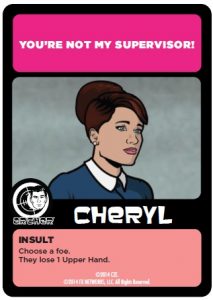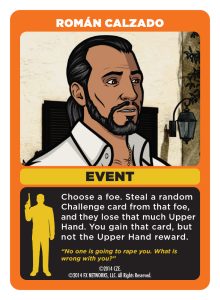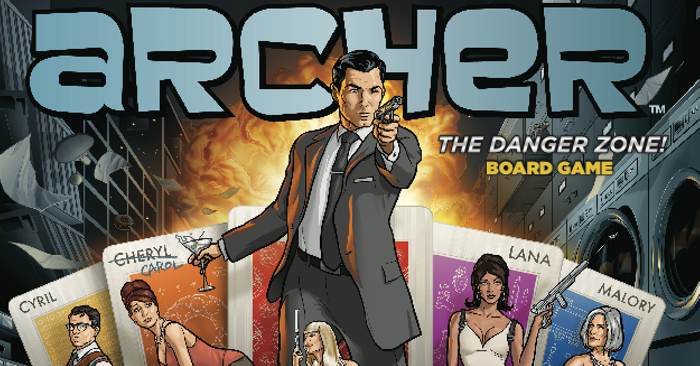Archer the Board Game: The Confusion Zone
A few months ago my wife was in our FLGS and saw Archer: the Board Game. “This looks awesome,” she said. She figured that since we were both fans of the show, we’d find it a blast. The shop owner; however, cautioned against it. Play was too clunky, he said. The game felt like a theme slapped on a game with no real playtesting. My wife put the game back on the shelf and we thought nothing else of it until last Wednesday, during our weekly board game night. Dice Dojo in Chicago has open tables on Wednesdays and we were meeting another couple to try out one of Dice Dojo’s hundreds of games. Lo and behold, one of our new friends picks up Archer. The shopkeeper’s warning is still fresh in our minds, but we agree to give it a chance. Sad to report the shopkeeper was right. Archer is clunkier than it needs to be, with too many mechanics and the most confusing rulebook I’ve seen this side of Axis and Allies. While I might play it again, it needs a few house rules to be enjoyable.
 The object of the game is to score 20 Upper Hand (Victory) points. At the start of the game, everyone picks a character from the show and gets that character’s deck of cards and tokens. Locations are set out depending on the number of players (more on this later). In the Location phase, players choose which location from the show they want to go to. Each Location does something different, and if multiple players are at the same Location, they hurl insults at each other using cards from their character deck. Insults are one way to gain or lose Upper Hand Points.
The object of the game is to score 20 Upper Hand (Victory) points. At the start of the game, everyone picks a character from the show and gets that character’s deck of cards and tokens. Locations are set out depending on the number of players (more on this later). In the Location phase, players choose which location from the show they want to go to. Each Location does something different, and if multiple players are at the same Location, they hurl insults at each other using cards from their character deck. Insults are one way to gain or lose Upper Hand Points.
Another way to gain Upper Hand Points is in the Challenges phase, which happens once all players are at their chosen Location. The Mission Leader attempts a Challenge by rolling a set of dice, which can be either one, two or three depending on how skilled your character is at that Challenge. Archer rolls three dice for Booze challenges, but only two dice for Smarts Challenges, while Lana rolls three dice for Guns Challenges. After all the Challenge cards are attempted the round is over and players return to the Location phase.
 The above two paragraphs are a distillation of the basic way to play the game and they take the place of a multi-page rulebook that’s one of the most confusing I’ve ever seen. The rulebook is verbose and unorganized, not the way to go about learning how to play this game. You’re better off watching an instructional video, or a play-through. Our group, for example, read the rules wrong and thought that the Locations changed every round, as there were only three Locations in place for our four-person group at any given time. This is wrong; Locations aren’t supposed to change. However, it feels like a very broken rule. Event cards, for example, only come into play in Mallory’s Office is in play, and when her office isn’t a part of the game, the Event deck doesn’t get touched 90% of the time. Likewise, it feels too easy to game the system for Mission Leaders and Initiative token-holders if certain Locations don’t swap out.
The above two paragraphs are a distillation of the basic way to play the game and they take the place of a multi-page rulebook that’s one of the most confusing I’ve ever seen. The rulebook is verbose and unorganized, not the way to go about learning how to play this game. You’re better off watching an instructional video, or a play-through. Our group, for example, read the rules wrong and thought that the Locations changed every round, as there were only three Locations in place for our four-person group at any given time. This is wrong; Locations aren’t supposed to change. However, it feels like a very broken rule. Event cards, for example, only come into play in Mallory’s Office is in play, and when her office isn’t a part of the game, the Event deck doesn’t get touched 90% of the time. Likewise, it feels too easy to game the system for Mission Leaders and Initiative token-holders if certain Locations don’t swap out.
There’s also too much going on in Archer. While there’s only two phases, the amount of stuff to keep track of feels like a lot for the game. It feels like a mishmash of worker placement and Munchkin-style silliness, together with cards and dice rolling. The character decks also feel like one of the weaker parts of the game. Sure, each deck is character-specific when it comes to insults. But the outcomes on the insult cards are largely the same. I would have liked to see either much more variation in the cards with character-specific abilities or a single deck of insult cards for the table.
Speaking of Munchkin, Archer suffers from the same kind of gang-up-on-the-leader tactic. When one player is getting close to 20 Upper Hand points it’s easy to focus everyone’s energy on that player and knock them back down a few points. Another house rule would work well here, one that makes it illegal to attack the person that was last attacked. This might speed up the game, as our game dragged one because we kept ganging up on the leader.
All in all, I like the concept of Archer: the Board Game. I just wish it went through a little more polish and play-testing before release. It’s not a broken game, but it does need some house rules to make it more enjoyable. A martini or two during gaming wouldn’t hurt either.
Archer: the Board Game tl;drs
Plays: 2-8 secret agents
Tested: 4 people who love the show, but haven’t played before
Recommended Reading: BoardGameGeek info and reviews





